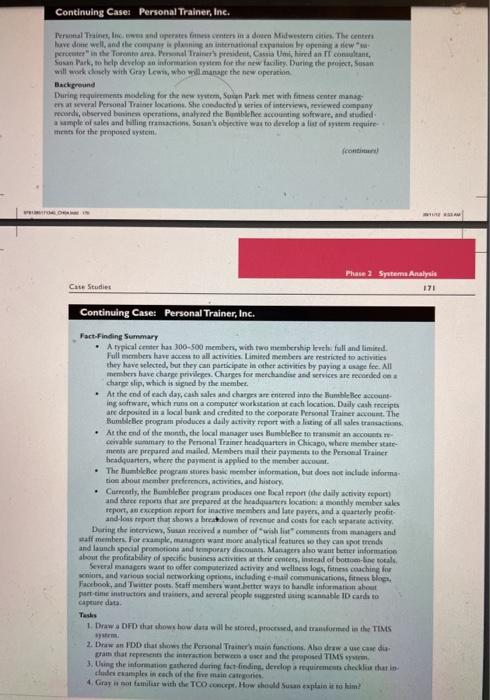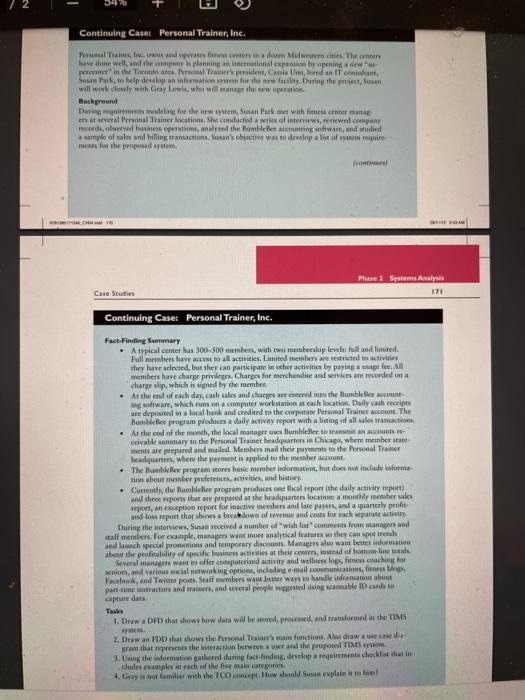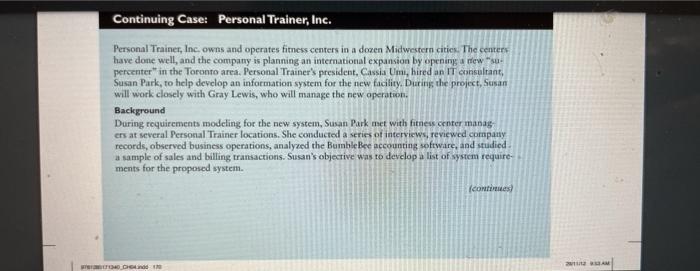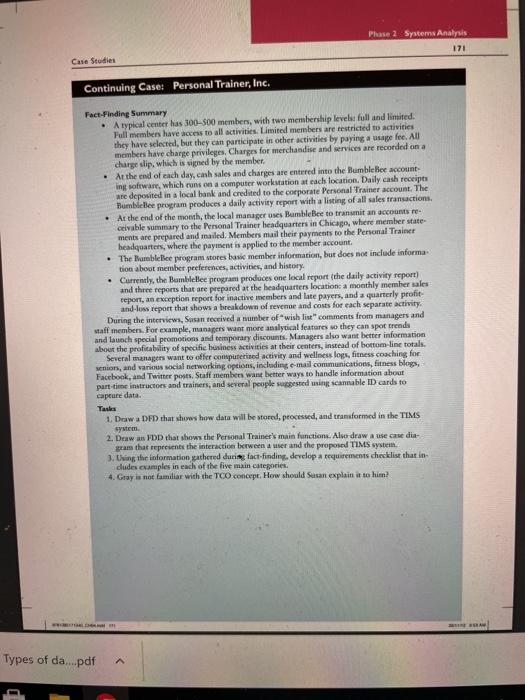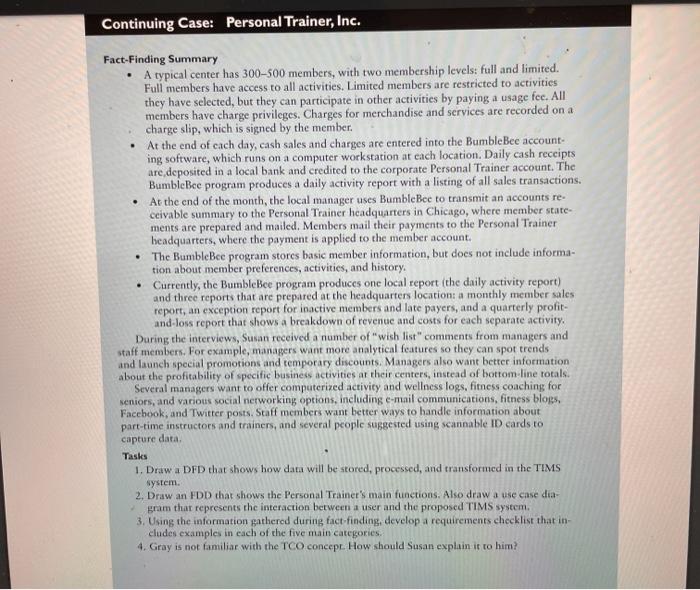Continuing Case: Personal Trainer, Inc. Termal Trainer, Inown operationens centers in den Midwestern cities. The have done well, and the company is planning an international expansion by opening a new percenter" in the Tortora. Ponal Trainer's president, Casuta Umi, hired an contant, Susan Mack, to help develop an information system for the new facility. During the project, Susan will work deely with Gray Lewis, who will manage the new operation Background During requirements modeling for the new system, Sean Park met with fitness center manag several Personal Trainer location. She conductedy series of interviews, reviewed company recordi, observed boninen operations, analyzed the Bumblebee accounting software, and tudied ample of sales and willing transactions Susan objective was to develop a list of sem require ments for the proposed system continuar Phase 2 Systems Analysis 171 Case Studies Continuing Case: Personal Trainer, Inc. Fact Finding Summary A typical center has 300-500 members, with two membership level full and limited Full members have access to all activities Limited members are restricted to activities they have selected, but they can participate in other activities by paying a usage fee. All members have charge privileges Charges for merchandise and services are recorded on change slip, which is signed by the member . At the end of each day, cash sales and charges are entered into the Bumblebee sccount ing software, which runs on a computer workstation teach location. Daily cash recipes are deposited in a local bank and credited to the corporate Personal Trainer account. The Bumblebee program produces a daily activity report with a lezing of all sales transactions At the end of the month, the local managers Bumblebee to transmit an accounts cevable summary to the Personal Trainer headquarters in Chicago, where member state ments are prepared and mailed. Members mail their payments to the Personal Trainer headquarters, where the payment is applied to the member account The Bumblebee program stores hascomber information, but does not include informa tion about member prices, activities, and history . Currently, the Bumblebee program producer one Racal repon (the daily activity report) and three reports that are prepared at the headquarters location a monthly member sales report an exception report for inactive members and late payers, and a quarterly probit and loss report that shows a badown of revenue and costs for each separate activity During the interviews, Susan received a number of wishlist comments from managers and waff members. For example, managers want more analytical catures so they can spot trends and launch special promotions and temporary discount Managers also want better information about the profitability of specific business activities at their contes, instead of bottom-line totals, Several managers want to offer computerized activity and wellness logs, fitness coaching for wnions, and various social networking options, including e-mail communications, fitness blog Facebook and Twitter posts, Staff members wat better ways to handle information about part-time it and wings, and several people suggesteding annable ID card to capture data Tasks 1. Draw. DPD that shows how data will be stored, processed, and transformed in the TIMS sm 2. Draw a DD dat shows the personal Trainers mais functions. Ala dewwa we can dia rain that represents the interaction berwarna utand the proposed TIMS im. 3. Using the information gathered during fact-finding, develop a requirements checklisturi cludes amples in each of the fire mais conies 4 Gry not familiar with the TOO concepe. How should Suuan explain it to him? 34% + Continuing Case: Personal Trainer, Inc. mal Traine, wnd pricina de Milwer Themen have done well, and the company is planning toalepne by openie percenter in the Toronto area. Termal Trainer's president, Umi, hited an IT com, Sean Park, to help develop an information for the new faciley Buring the project, San will work dosely with Gray Lewis, who will wanach w operatio Background During requirements modeling for the new stem, San Park met with finess center mana en stryeral l'ersonal Trainer location. She conducted a series of interviews, reviewed.company recordanserved business operations, analysed the Humblebee sting software, and died ample of sales and willing tramaction Susan objective was to develop a line of serem require ents for the proposed system Phase 2 Systems Analysis 171 Case Studies Continuing Case: Personal Trainer, Inc. . Fact-Finding Summary A typical center has 300-500 members, with two membership level fall and limited Full members have acceso al activities Limited members are restricted to activities they have selected, but they can participate in other activities by paying fee. All members have change privileges Charges for merchandise and services are recorded on changes, which is wed by the membet At the end of each day, cash sales and charges and into the Bumblebee account ing software, which runs on a computer workstation at each location Dailych receipts are deposited in a local bank and credited to the corporate Personal Trainer The Bumblebee program produces a daily activity report with a listing of all sales transaction At the end of the month, the local managers Bumblebee tot accounts ceivable summary to the Personal Trainer headquarters in Chicago, where member state ments are prepared and mailed. Members mail their payments to the Personal Trainer headquarters, where the payment is applied to the member account. The Bumblelle program stores bus member information, but does not include informa tion about member preferences, activities, and history Currently, the Bumblebee program produces on cal report the daily activity report and the reports that are prepared at the headquarters location mobily member sales report an exception report for inactive members and are payers, and a quarterly profit and-loss sport that shows a breadows of revenue and.com for each parte activity During the interviews, Susan received a number of wish list come from mange and staff members. For example, managers want more analytical features so they can spot trends and launch special promotions and temporary discount Managers also want better information about the profitability of specific business activities at their content of hot-line toals Several manager want to offer computered activity and wellness log fitness coaching for senion, and various social networking options, including email.comcations, time big Facebook and Twitter posts Staff members want better ways to handle information about part time instructors and trainers, and everal people gesteding cable ID candet Tasks 1. Dwa DFD that shows how lata will be stored, proceed and transformed in the 'TIMS system 2. Dewan PDD that shows the Perional Trainer's main functions. Also draw a secunda gram that represents the interaction between awer and the proposed TIMS m 1. Ung the indumatic gathered during fact-findings, develop a girements checklist that cludes amples in each of the five main categories 4. Gray is sot familiar with the TOO concept How should Susan explain tim! Continuing Case: Personal Trainer, Inc. Personal Trainer, Inc. owns and operates fitness centers in a dozen Madwestern cities. The centers have done well, and the company is planning an international expansion by opening a new su- percenter" in the Toronto area. Personal Trainer's president, Cassia Umi, hired an IT consultant, Susan Park, to help develop an information system for the new facility. During the project, Susan will work closely with Gray Lewis, who will manage the new operation, Background During requirements modeling for the new system, Susan Park met with fitnes center manag ers at several Personal Trainer locations. She conducted a series of interviews, reviewed company records, observed business operations, analyzed the Bumble Bee accounting software, and studied a sample of sales and billing transactions. Susan's objective was to develop a list of system require ments for the proposed system. contes 2 AM D G Phase 2 Systems Analysis 171 Case Studies Continuing Case: Personal Trainer, Inc. Fact-Finding Summary A typical center has 300-500 members, with two membership levels full and limited. Pull members have access to all activities Limited members are restricted to activities they have selected, but they can participate in other activities by paying a usage fee. All members have charge privileges, Charges for merchandise and services are recorded on a charge slip, which is signed by the member At the end of each day, cash sales and charges are entered into the Bumblebee account ing software, which runs on a computer workstation at each location. Daily cash receipts are deposited in a local bank and credited to the corporate Personal Trainer account. The Bumblebee program produces a daily activity report with a listing of all sales transactions. At the end of the month, the local manager uses BumbleBee to transmit an accounts re- ceivable summary to the Personal Trainer headquarters in Chicago, where member state ments are prepared and mailed. Members mail their payments to the Penonal Trainer headquarters, where the payment is applied to the member account. The Bumblelee program stores basic member information, but does not include informa tion about member preferences, activities, and history. Currently, the Bumblebee program produces one local report the daily activity report) and three reports that are prepared at the headquarters locationc a monthly member sales report, an exception report for inactive members and late payers, and a quarterly profit- and loss report that shows a breakdown of revenue and costs for each separate activity. During the interviews, Susan received a number of wish list comments from managers and staff members. For example, managers want more analytical features so they can spot trends and launch special promotions and temporary discounts Managers also want better information about the profitability of specific business activities at their centers, instead of bottom line totals. Several managers want to offer computerized activity and wellness logs, fimesscoaching for seniors, and various social networking options, including e-mail communications, fitness blogs Facebook and Twitter posts Staff members want better ways to handle information about part-time instructors and trainers, and several people suggested using scannable ID cards to capture data Tasks 1. Draw a DFD that shows how data will be stored, processed, and transformed in the TIMS System. 2. Dewan FDD that shows the Personal Trainer's main functions. Also draw a use case dia- gram that represents the interaction between a user and the proposed TIMS system, 3. Using the information gathered during fact-finding develop a requirements checklist that in dudes samples in each of the five main categories 4. Gray is not familiar with the TCO concept. How should Susan explain it to him? Types of da....pdf Continuing Case: Personal Trainer, Inc. . Fact-Finding Summary A typical center has 300-500 members, with two membership levels: full and limited. Full members have access to all activities. Limited members are restricted to activities they have selected, but they can participate in other activities by paying a usage fee. All members have charge privileges. Charges for merchandise and services are recorded on a charge slip, which is signed by the member. At the end of each day, cash sales and charges are entered into the Bumble Bee account ing software, which runs on a computer workstation at cach location. Daily cash receipts are deposited in a local bank and credited to the corporate Personal Trainer account. The BumbleBee program produces a daily activity report with a listing of all sales transactions. At the end of the month, the local manager uses BumbleBee to transmit an accounts re- ceivable summary to the Personal Trainer headquarters in Chicago, where member state- ments are prepared and mailed. Members mail their payments to the Personal Trainer headquarters, where the payment is applied to the member account. The BumbleBee program stores basic member information, but does not include informa- tion about member preferences, activities, and history. Currently, the BumbleBee program produces one local report (the daily activity report) and three reports that are prepared at the headquarters location: a monthly member sales report, an exception report for inactive members and late payers, and a quarterly profit- and-loss report that shows a breakdown of revenue and costs for each separate activity. During the interviews, Susan received a number of "wish list" comments from managers and staff members. For example, managers want more analytical features so they can spot trends and launch special promotions and temporary discounts. Managers also want better information about the profitability of specific business activities ar their centers, instead of bottom line totals. Several managers want to offer computerized activity and wellness logs, fitness coaching for seniors, and various social networking options, including e-mail communications, fitness blogs Facebook, and Twitter posts. Staff members want better ways to handle information about part-time instructors and trainers, and several people suggested using scannable ID cards to capture data Tasks 1. Draw a DFD that shows how data will be stored, processed, and transformed in the TIMS system. 2. Draw an FDD that shows the Personal Trainer's main functions. Also draw a use case dia- gram that represents the interaction between a user and the proposed TIMS system. 3. Using the information gathered during fact-finding, develop a requirements checklist that in cludes examples in each of the five main categories. 4. Gray is not familiar with the TCO concept. How should Susan explain it to him
